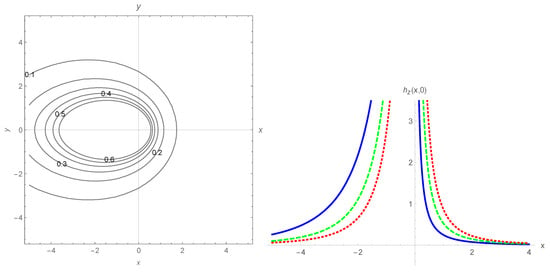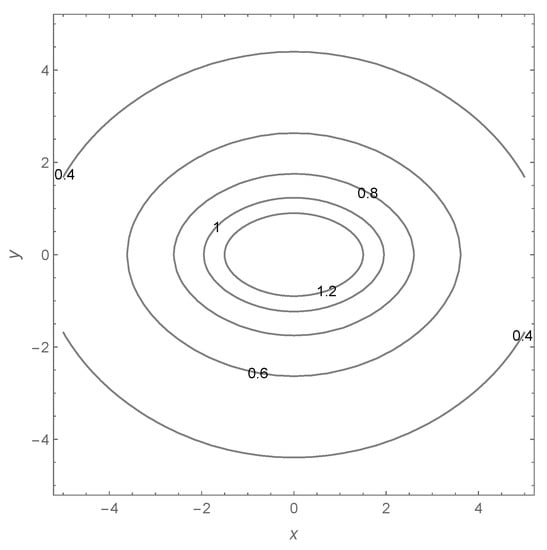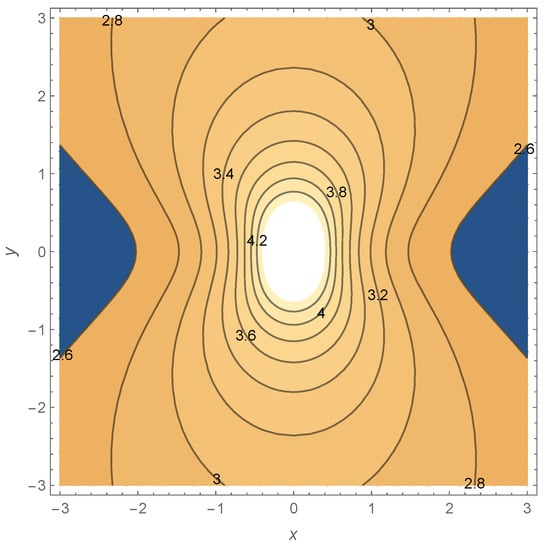Abstract
The magnetic field of a moving Pearl vortex in a superconducting thin-film in plane is studied with the help of the time-dependent London equation. It is found that for a vortex at the origin moving in direction, is suppressed in front of the vortex, , and enhanced behind (). The distribution asymmetry is proportional to the velocity and to the conductivity of normal quasiparticles. The vortex self-energy and the interaction of two moving vortices are evaluated.
1. Introduction
The time-dependent Ginzburg–Landau equations (GL) are the major tool in modeling vortex motion. Although this approach is applicable only for gapless systems near the critical temperature [1], it is gauge invariant and reproduces correctly major features of the vortex motion.
A simpler linear London approach has been employed through the years to describe static or nearly static vortex systems. The London equations express the basic Meissner effect and can be used at any temperature for problems where vortex cores are irrelevant. Moving vortices are commonly considered the same as static which are displaced as a whole.
However, recently it has been shown that this is not the case for moving vortex-like topological defects in, e.g., neutral superfluids or liquid crystals [2]. This is not so in superconductors within the time-dependent London theory (TDL) which takes into account normal currents, a necessary consequence of moving magnetic structure of a vortex [3,4]. In this paper, the magnetic field distribution of moving Pearl vortices in thin films is considered. It is shown that the self-energy of a moving vortex decreases with increasing velocity. The interaction energy of two vortices moving with the same velocity becomes anisotropic; it is enhanced when the vector connecting vortices is parallel to the velocity and suppressed if . The magnetic flux carried by moving vortex is equal to flux quantum, but this flux is redistributed so that the part of it in front of the vortex is depleted, whereas the part behind it is enhanced.
In time-dependent situations, the current consists, in general, of normal and superconducting parts:
where is the electric field and is the order parameter.
The conductivity approaches the normal state value when the temperature T approaches ; in s-wave superconductors it vanishes fast with decreasing temperature along with the density of normal excitations. This is not the case for strong pair breaking when superconductivity becomes gapless, and the density of states approaches the normal state value at all temperatures. Unfortunately, there is not much experimental information about the T dependence of . Theoretically, this question is still debated; e.g., [5] discusses the possible enhancement of due to inelastic scattering.
Within the London approach is a constant , and Equation (1) becomes:
where is the London penetration depth. By acting on this via curling, one obtains:
where is the position of the -th vortex; is the direction of vortices. Equation (3) can be considered as a general form of the time-dependent London equation.
The time-dependent version of London Equation (3) is valid only outside vortex cores, similarly to the static London approach. As such, it may give useful results for materials with large GL parameter values in fields away from the upper critical field . On the other hand, Equation (3) is a useful, albeit approximate tool for low temperatures where GL theory does not work and the microscopic theory is forbiddingly complex.
2. Thin Films
Let the film of thickness d be in the plane. Integration of Equation (3) over the film thickness gives, for the z component of the field, a Pearl vortex moving with velocity :
Here, is the flux quantum; is the sheet current density related to the tangential field components at the upper film face by ; is the Pearl length; and . With the help of div, this equation is transformed to:
As was shown by Pearl [6], a large contribution to the energy of a vortex in a thin film comes from stray fields. In fact, the problem of a vortex in a thin film is reduced to that of the field distribution in free space subject to the boundary condition supplied by solutions of Equation (4) at the film’s surface. Outside the film curl div, one can introduce a scalar potential for the outside field:
The general form of the potential satisfying Laplace equation that vanishes at of the empty upper half-space is
Here, , , and is the two-dimensional Fourier transform of . In the lower half-space, one has to replace in Equation (7).
As is done in [3], one applies the 2D Fourier transform to Equation (5) to obtain a linear differential equation for . Since , we obtain:
In fact, this gives distributions for all field components outside the film, its surface included. In particular, at (the upper film face) is given by
We are interested in the vortex’s motion with constant velocity , so that we can evaluate this field in real space for the vortex at the origin at :
It is convenient in the following to use Pearl as the unit length and measure the field in units :
(we left the same notations for and in new units; when needed, we indicate formulas written in common units).
2.1. Evaluation of
With the help of identity
one rewrites the field as
To evaluate the last integral over , we note that the three-dimensional (3D) Coulomb Green’s function is
To do here the last step, we used , and
It follows from Equation (14)
Replace now , , to obtain instead of Equation (13):
After integrating by parts, one obtains:
For the Pearl vortex at rest , , and the known result follows; see, e.g., [7]:
and are second-kind Bessel and Struve functions.
Hence, we succeeded in reducing the double integral (11) to a single integral over u. Besides, the singularity at is now explicitly represented by , whereas the integral over u is convergent and can be evaluated numerically.
The results are shown in Figure 1.

Figure 1.
The left panel: contours of const ( is in units and in units of ) for . The right one: for (dotted red), (dashed green), and (solid blue).
The field distribution is not symmetrical relative to the singularity position: the field in front of the moving vortex is suppressed relative to the symmetric distribution of the vortex at rest, whereas behind the vortex it is enhanced. This is an interesting consequence of our calculations: the magnetic flux of the moving vortex is redistributed so that it is depleted in front of the vortex and enhanced behind it.
We can characterize this redistribution by calculating the magnetic flux in front of the vortex:
The integral over y gives , whereas when integrating over we use
where indicates that the integral over in Equation (20) should be understood as the principal value. Hence, we have
The integration now is straightforward and we obtain
Note that the total flux carried by vortex is given by Fourier component ; see Equation (9). I.e., is the flux through the half-plane of the vortex at rest. The flux behind the moving vortex is therefore
2.2. Potential and London Energy of the Moving Vortex
The potential introduced above is useful not only as an intermediate step in the evaluation of a magnetic field; it is directly related to the London energy (the sum of the magnetic energy outside the film and the kinetic energy of the currents inside) [8].
2.2.1. Self-Energy of a Moving Vortex
This energy is given by
whereas the integral (26) in this limit is logarithmically divergent. As is commonly done, we can approach the singularity at from any side—e.g., setting and , the core size is:
for the small dimensionless . Compare this with the energy of a vortex at rest; see, e.g., [8]:
Hence, the vortex self-energy decreases with increasing velocity, a result qualitatively similar to that of moving vortices in the bulk [4].
2.2.2. Interaction of Moving Vortices
It has been shown in [8] that in infinite films the interaction is given by ; is the potential of the vortex at the origin at the position of the second. Using Equation (26) we obtain
Clearly, . This energy can be evaluated numerically and the result is shown in Figure 2 for .

Figure 2.
Contours of constant interaction energy for .
It is worth noting that in thin films the interaction is not proportional to the field of one vortex at the position of the second. In our case the field of one vortex (see Figure 1) is not symmetric relative to , whereas the interaction energy is.
2.3. Electric Field and Dissipation
Having the magnetic field (9) of a moving vortex, one gets for two vortices, one at the origin and the second at :
(in common units). The moving, nonuniform vortex’s magnetic field causes an electric field out of the vortex core, which in turn causes the normal currents and the dissipation . Usually this dissipation is small relative to Bardeen–Stephen core dissipation [9], but for fast vortex motion and high conductivity of normal excitations [5] it can become substantial [3].
The field caused by known is given by Maxwell equations and :
For a constant velocity, one can consider the dissipation at . The dissipation power is:
The integral here is divergent at large k, but the London theory breaks down in the vortex core of a size , so one can introduce a factor to truncate this divergence. We then calculate the reduced quantity shown in Figure 3.

Figure 3.
Contours of constant dissipation in the system of two moving vortices for . At one is situated at the origin and the second at .
We note that the dissipation develops a shallow ditch along the x axis. Hence, for a fixed separation of vortices in the pair, the dissipation is minimal if they are aligned along the velocity.
3. Discussion
We have shown that in thin films the magnetic structure of the moving Pearl vortex is distorted relative to the vortex at rest. A similar formal procedure can be employed for moving Abrikosov vortices in the bulk, see Appendix A. The flux quantum of a moving vortex is redistributed and the back side of the flux is enhanced, whereas the front side is depleted. Physically, the distortion is caused by normal currents arising due to changing in time magnetic field at each point in space; the electric field is induced and causes normal currents. Naturally, it leads to the suppression of the flux where it is increasing (in front of the moving vortex) and to enhancement where it is decreasing (behind the vortex). We characterize this asymmetry by the difference of fluxes behind () and in front () of the moving vortex . For a realistic situation, , although the relaxation time where is the poorly-known conductivity of above-the-gap normal excitations. Measuring one can extract , an important physical characteristic of superconductors. There is an experimental technique which, in principle, could probe the field distribution in moving vortices [10]. This is highly sensitive SQUID-on-tip with the loop small on the scale of possible Pearl lengths.
Recent experiments have traced vortices moving in thin superconducting films with velocities well exceeding the speed of sound [10,11]. Vortices crossing thin-film bridges being pushed by transport currents have a tendency to form chains directed along the velocity. The spacing of vortices in a chain is usually exceeded by much of the core size, so the commonly accepted reason for the chain formation, namely, the depletion of the order parameter behind moving vortices, is questionable. However, at distances the time-dependent London theory is applicable. Another promising technique for studying moving vortices is Tonomura’s Lorentz microscopy [12].
In this paper, we consider only properties of a single vortex and of interaction between two vortices moving with the same velocity, It would be interesting to consider how these results change if the quantization of the transverse electron motion is taken into account [13]. The problem of interaction in systems of many vortices is still to be considered.
Author Contributions
Conceptualization, V.K.; original draft preparation, V.K.; writing—review and editing, V.K. and N.N. The rest had been done by both authors. All authors have read and agreed to the published version of the manuscript.
Funding
This research received no external funding.
Data Availability Statement
Not applicable.
Acknowledgments
The work of V.K. was supported by the U.S. Department of Energy (DOE), Office of Science, Basic Energy Sciences, Materials Science, and Engineering Division. Ames Laboratory is operated for the U.S. DOE by Iowa State University under contract DE-AC02-07CH11358.
Conflicts of Interest
The authors declare no conflict of interest.
Appendix A. Abrikosov Vortex Moving in the Bulk
The field distribution of this case has been evaluated numerically in [3]. Here, we provide this distribution in closed analytic form.
The magnetic field h has one component , so we can omit the subscript z. By choosing as a unit length and measuring the field in units of , we have:
First, we use the identity
so that
Now, integrals over are doable:
where . Hence, we have
The last line is written in common units. Note that for the vortex at rest, , and we get the standard result [14].
This section is not mandatory, but may be added if there are patents resulting from the work reported in this manuscript.
References
- Gor’kov, L.P.; Kopnin, N.B. Vortex motion and resistance of type-II superconductors in magnetic field. Usp. Fiz. Nauk. 1975, 116, 413. [Google Scholar] [CrossRef]
- Radzihovsky, L. Anomalous Energetics and Dynamics of Moving Vortices. Phys. Rev. Lett. 2015, 115, 247801. [Google Scholar] [CrossRef] [PubMed]
- Kogan, V.G. Time-dependent London approach: Dissipation due to out-of-core normal excitations by moving vortices. Phys. Rev. B 2018, 97, 094510. [Google Scholar] [CrossRef]
- Kogan, V.G.; Prozorov, R. Interaction between moving Abrikosov vortices in type-II superconductors. Phys. Rev. B 2020, 102, 024506. [Google Scholar] [CrossRef]
- Smith, M.; Andreev, A.V.; Spivak, B.Z. Debye mechanism of giant microwave absorption in superconductors. Phys. Rev. B 2020, 101, 134508. [Google Scholar] [CrossRef]
- Pearl, J. Current distribution in superconducting films carrying quantized fluxoids. Appl. Phys. Lett. 1964, 5, 65. [Google Scholar] [CrossRef]
- Kogan, V.G.; Dobrovitski, V.V.; Clem, J.R.; Mawatari, Y.; Mints, R.G. Josephson junction in a thin film. Phys. Rev. B 2001, 63, 144501. [Google Scholar] [CrossRef]
- Kogan, V.G. Interaction of vortices in thin superconducting films and the Berezinskii-Kosterlitz-Thouless transition. Phys. Rev. B 2007, 75, 064514. [Google Scholar] [CrossRef]
- Bardeen, J.; Stephen, M.J. Theory of the motion of vortices in superconductors. Phys. Rev. 1965, 140, A1197. [Google Scholar] [CrossRef]
- Embon, L.; Anahory, Y.; Jelić, Ž.L.; Lachman, E.O.; Myasoedov, Y.; Huber, M.E.; Mikitik, G.P.; Silhanek, A.V.; Milosević, M.V.; Gurevich, A.; et al. Imaging of super-fast dynamics and flow instabilities of superconducting vortices. Nat. Commun. 2017, 8, 85. [Google Scholar] [CrossRef] [PubMed]
- Dobrovolskiy, O.V.; Vodolazov, D.Y.; Porrati, F.; Sachser, R.; Bevz, V.M.; Mikhailov, M.Y.; Chumak, A.V.; Huth, M. Ultra-fast vortex motion in dirty Nb-C superconductor with a close-to-perfect edge barrier. Nat. Commun. 2020, 11, 3291. [Google Scholar] [CrossRef] [PubMed]
- Bonevich, J.E.; Harada, K.; Matsuda, T.; Kasai, H.; Yoshida, T.; Pozzi, G.; Tonomura, A. Electron holography observation of vortex lattices in a superconductor. Phys. Rev. Lett. 1993, 70, 2952. [Google Scholar] [CrossRef] [PubMed]
- Shanenko, A.A.; Orlova, N.V.; Vagov, A.; Milošević, M.V.; Axt, V.M.; Peeters, F.M. Nanofilms as quantum-engineered multiband superconductors: The Ginzburg-Landau theory. EPL 2013, 102, 27003. [Google Scholar] [CrossRef]
- De Gennes, P. Superconductivity of Metals and Alloys; Benjamin: New York, NY, USA, 1966. [Google Scholar]
Publisher’s Note: MDPI stays neutral with regard to jurisdictional claims in published maps and institutional affiliations. |
© 2021 by the authors. Licensee MDPI, Basel, Switzerland. This article is an open access article distributed under the terms and conditions of the Creative Commons Attribution (CC BY) license (http://creativecommons.org/licenses/by/4.0/).